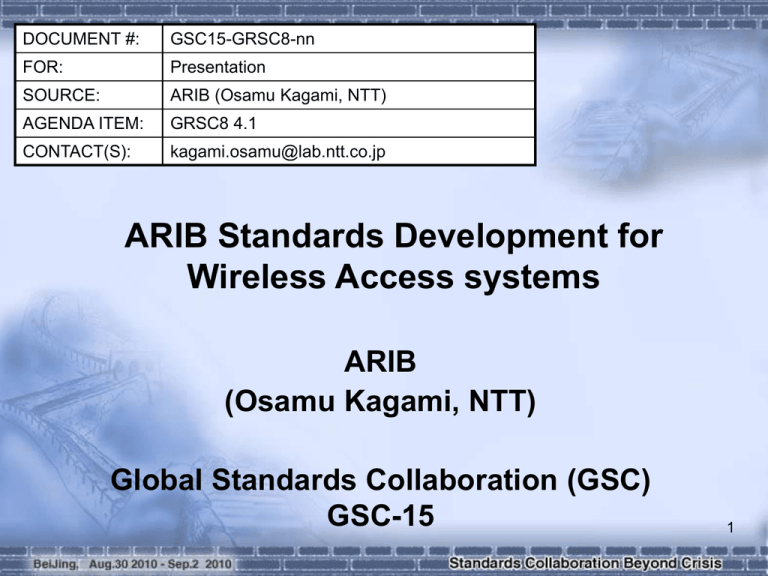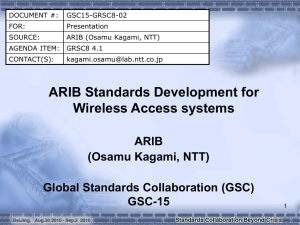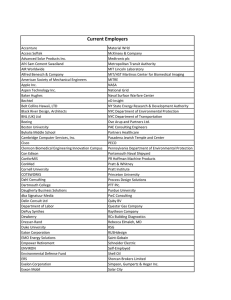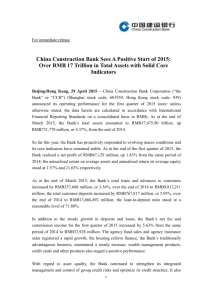DOCUMENT #: GSC15-GRSC8-nn FOR: Presentation
advertisement

DOCUMENT #: GSC15-GRSC8-nn FOR: Presentation SOURCE: ARIB (Osamu Kagami, NTT) AGENDA ITEM: GRSC8 4.1 CONTACT(S): kagami.osamu@lab.ntt.co.jp ARIB Standards Development for Wireless Access systems ARIB (Osamu Kagami, NTT) Global Standards Collaboration (GSC) GSC-15 1 Highlight of Current Activities (1) 5 working groups (including 4 technical working groups) have been constituted in MMAC Forum to make technical investigation, study on system specifications, liaison with other standardization bodies, promotion of demonstrative experiments and popularization activities. 1. Promotion-WG Planning and managing promotion and popularization activities of the Forum 2. MMAC802.11-WG (ARIB STD-T71) Study on the high throughput WLANs (> 1Gbps) that are under development in IEEE 802.11 TGac and TGad Liaison with IEEE802.11 for updating ARIB STD-T71(TGn etc.) 3. UWB-WG (ARIB STD-T91) Investigation of interference mitigation function for UWB system in Europe and Japan Experimental test of the propagation of UWB system considering real environments Exchange of information regarding the interference mitigation function among Asian countries 4. mmWPAN-WG Study on standardization of millimeter-wave wireless PAN Making a draft standard of millimeter- wave wireless PAN in Japan MMAC: Multimedia Mobile Access Communications System mmWPAN: Millimeter-wave Wireless Personal Area Network 2 Highlight of Current Activities (2) 5. Wide Area Ubiquitous Network (WAUN) -WG Study on the WAUN system • Motivational research of sensor and/or actuator communications • Studies of system requirements and technical specifications of the system • Contribution to the allocation of the radio frequency spectrum for the system Developing a standard of the WAUN system • What’s the WAUN system? It is the large cell-based public mobile wireless access system for sensor and actuator communications. It supports a variety of service applications that handle small amounts of data at comparatively long intervals such as automation and efficiency enhancement of business works, environment observation, remote control of plant facilities and social security. 3 Strategic Direction Further studies of technical specifications of the WAUN system toward a development of the ARIB standard • Air interface to keep communication capacity, quality and security that are suitable for sensor and/or actuator communications • Technologies to provide economical communication services with simple, small and inexpensive wireless terminal Activities toward the global harmonization • Establishment of ITU-R recommendation/report New question was already set up as Question ITU-R 250/5. • Investigation of the similar activities and directions in other standardization bodies and countries IoT (Internet of Things) project in China SUN (Smart Utility Network) in IEEE802.15.4g Smart Grid, Smart metering (ETSI TC M2M), etc. 4 Challenges Wide Area Ubiquitous Network-WG will contribute towards Making ITU-R recommendation/report on: the technical and operational requirements, and the feasibility studies of sensor and/or actuator communications. Developing fundamental technical documents for: the frequency allocation for WAUN system in Japan, and the revision of Japanese Radio Regulations. 5 Next Steps/Actions Wide Area Ubiquitous Network-WG • Studies on technical specifications of WAUN system • Development of ARIB standard in FY2012 6 Supplementary Slides 7 What is MMAC? Objective To realize MMAC (Multimedia Mobile Access Communication Systems) through investigations of system specifications, demonstrative experiment, information exchange and popularization activities and thereby contribute to the efficient use of radio frequency spectrum. Activities 1. 2. 3. 4. 5. Investigation Study on system specifications Demonstrative experiment Information exchange and popularization activities Other business Establishment December 4, 1996 8 Organization General Assembly Officers-Members Promotion-WG Executive Committee MMAC802.11-WG Steering Committee UWB-WG mmWPAN-WG Wide Area Ubiquitous Network-WG 9 Target specifications of MMAC Wireless Access System Service area Public space, Private space (outdoor, indoor) Connected networks, Interface Public network, Private network (Ethernet, ATM, IEEE1394 etc.) Information rate Up to 1Gbps Terminal equipment PCs and Audio Visual Equipments etc. Mobility Radio frequency bands Bandwidth Bit error rate Still or pedestrian (with hand-over) Micro-wave band and millimeter-wave band Up to 1,000MHz Equivalent to wire line networks (around 10-6 to 10-8) 10 MMAC Forum coverage area Coverage area Cellular System MMAC area The 3rd generation (3G: W-CDMA, CDMA2000 1X, etc) The 3.5th generation (3.5G: HSPA, EV-DO) The 3.9th generation (3.9G: LTE, UMB) The 4th generation IMT-Advance Next generation PHS PHS MBWA(IEEE802.20) MAN Beyond 3rd generation FWA(IEEE802.16a 16e) Wide area ubiquitous network MMAC area HiSWANa HiSWANb 802.11a/g 802.11n Wireless1394 LAN IEEE802.11 PAN 802.11b Bluetooth(IEEE802.15.1) UWB Millimeter wave (IEEE802.15.3c) ZigBee(IEEE802.15.4) 100k 802.11ac/802.11ad 1M 10M 100M 1G 10G Information rate 11 Target Layer Layer WG MMAC 802.11 UWB mmWPAN Wide Area Ubiquitous Network 7 Application 6 Presentation 5 Session 4 Transport 3 Network 2 Data Link (LLC) 2 Data link (MAC) 1 Physical 12 Schedule FY2009 FY2010 FY2011 Study on TGn Study on TGac and TGad 802.11-WG Study on WLAN, drafting a revision of T71, etc. Study on interference mitigation function for UWB Experimental test of propagation of UWB UWB-WG Exchange of information regarding the interference mitigation function among standard-setting organizations. Drafting a revision of T91 mmWPAN -WG Wide Area Ubiquitous NW-WG Liaison with IEEE802.15.3c Drafting a standard of mm WPAN in Japan Study on Wide Area Ubiquitous Network Study on techniques for Wide Area Ubiquitous Network Study for establishment of ITU-R recommendation for the Wide Area Ubiquitous Network 13 MMAC Concept 14 Global Standardization Relationship 15 MMAC Members Advanced Telecommunications Research Institute national Agilent Technologies Japan, Ltd. Atheros Communications, Inc. BUFFALO INC. CANON INC. CASIO COMPUTER CO., LTD. DATATrak Co., Ltd. DENSO CORPORATION France Telecom Japan Co., Ltd. FUJITSU LIMITED FUJITSU TEN LIMITED Fuji Xerox Co., Ltd. Futaba Corporation Hitachi Kokusai Electric Inc. Hitachi, Ltd. IBM Japan, Ltd. Icom Inc. Intel Corporation Iwatsu Electric Co., Ltd. Japan Radio Co., Ltd. Kandenko Co., Ltd. The Kansai Electric Power Co., Inc. KDDI CORPORATION Mitsubishi Electric Corporation Motorola Japan Ltd. Murata Manufacturing Co., Ltd. Nassua Solutions Corporation NEC Corporation NEC Infrontia Corporation NIHON DEMPA KOGYO CO., LTD. NIHON DENGYO KOSAKU CO., LTD. NIPPON TELEGRAPH AND TELEPHONE CORPORATION NTT DoCoMo, Inc. NTT Electronics Corporation Oki Electric Industry Co., Ltd. Panasonic Corporation Panasonic Electric Works Co., Ltd. Panasonic Mobile Communications Co., Ltd. Pioneer Corporation QUALCOMM Incorporated Renesas Electronics Corporation Ricoh Co., Ltd. SANYO Electric Co., Ltd. SAXA, Inc. SEIKO EPSON CORPORATION SOFTBANK MOBILE Corp. Sony Corporation SOSHIN ELECTRIC CO., LTD. SUMITOMO ELECTRIC DEVICE INNOVATIONS, INC. Taiyo Yuden Co., Ltd. TDK Corporation Telecom Engineering Center Toho Technology Corporation The Tokyo Electric Power Company, Incorporated Toshiba Corporation TOSHIBA TEC CORPORATION TOYOTA Info Technology Center Co., Ltd. TOYOTA MOTOR CORPORATION UM-Services, Ltd. Wisair Ltd. as of Jun. 28, 2010. 69 members YAGI ANTENNA INC. Yokogawa Electric Corporation (incl. special members) 16 System configuration of WAUN Outdoor TE WT AP GW TE WT Public IPnetwork Outdoor GW TE WT AP TE GW WT TE WT AP Air interface for study TE WT Indoor (pico/femto cell) GW: Gateway AP: Access Point WT: Wireless Terminal TE: Terminal equipment for users 17 Technical specification WAUN 3G-mobile Zigbee RFID WLAN (under discussion) (W-CDMA) (IEEE802.15.4) (ISO-18000-7) (IEEE802.11n) Frequency band VHF/UHF band 2GHz, 800/900MHz 2.4GHz 433MHz 5GHz 2.5GHz Modulation p/4-QPSK UL: BPSK DL: QPSK OQPSK FSK 64QAM (OFDM) UL: 64QAM DL: 16QAM 25kHz 5MHz 2MHz 500kHz 20MHz 10MHz Data Trans. rate 9.6kbps UL: 64kbps DL: 384kbps 250kbps 27.7kbps 40Mbps (2x2MIMO) UL: 10Mbps DL: 40Mbps Trans. power < 10mW < 250mW < 1mW < 4mW < 200mW < 200mW Cell radius 3 - 5km 1.5km 100m 30m 100m 2km Battery life 5 yrs. 2 weeks 2yrs. 2 - 3 yrs. - ‐ System Channel separation (wireless terminal) (approx.) (DS-SS) WiMAX (OFDM/OFDMA) (2x2MIMO) UL: Up-link DL: Down-link 18




